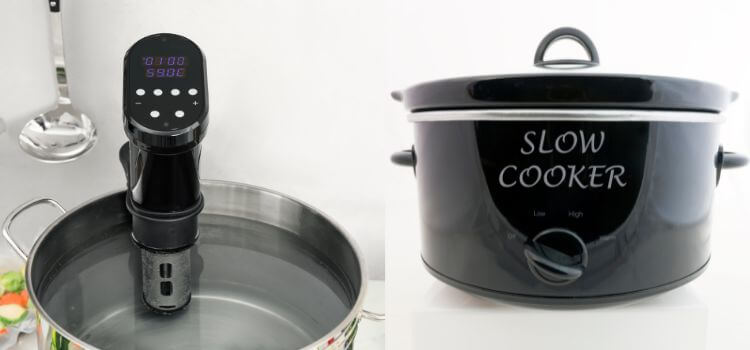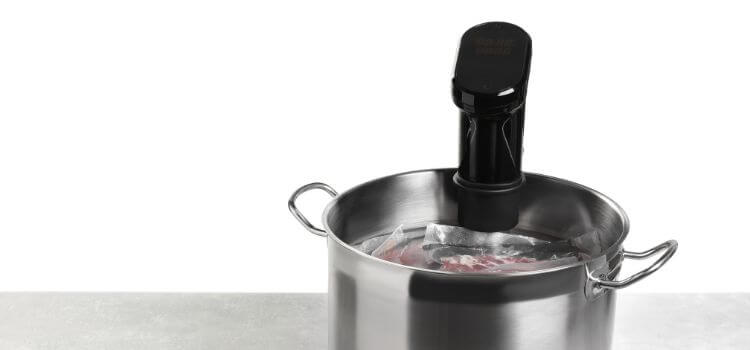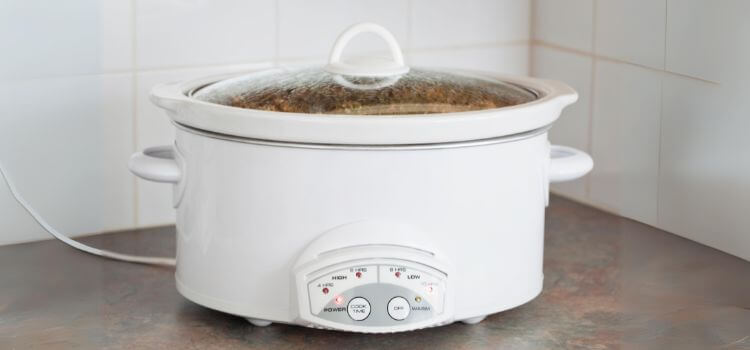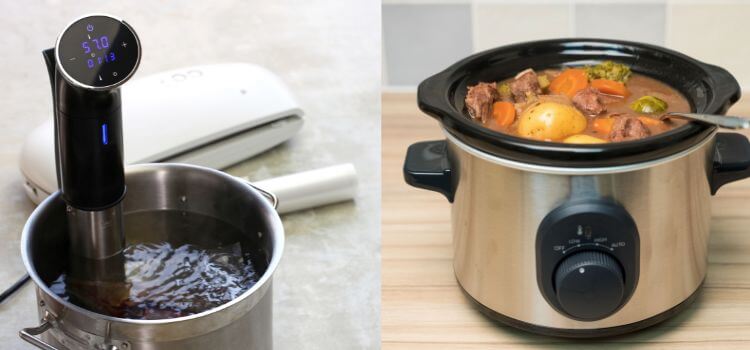As an Amazon Associate, I earn from qualifying purchases

In the world of culinary arts, the quest for the perfect cooking method is ongoing and ever-evolving. Among the array of techniques that have captured the attention of home cooks and professional chefs alike, two methods stand out for their ability to transform ingredients into tender, flavorful dishes: sous vide and slow cooking.
While both approaches share a common goal of enhancing the natural tastes and textures of food, they diverge significantly in their methodology, equipment, and outcomes. In this article, we delve into the nuanced world of sous vide versus slow cooking, comparing and contrasting these popular techniques to help you decide which might best suit your culinary needs and preferences.
What is a Sous Vide?

Sous vide, a French phrase meaning “under vacuum,” refers to a cooking method in which food is sealed in a pouch and cooked in a carefully regulated water bath. Initially used by gourmet chefs, sous vide has become famous for home cooks with sous vide machines. This method involves slow-cooking food at a steady temperature for perfectly cooked dishes, ideal for delicate proteins like fish and eggs.
How it works
To cook using sous vide, you’ll need a vacuum sealer for airtight bags. Submerge these bags in a water bath and set the temperature precisely using a sous vide machine. Sous vide’s precise temperature control ensures even cooking from edge to edge, eliminating overcooking. Cooking times range from 30 minutes to hours, depending on ingredients and desired doneness.
Pros of Sous Vide Cooking
- Temperature control: Sous vide cooking provides meticulous temperature control, ensuring food is cooked consistently and evenly. This makes it perfect for dishes that require a specific level of doneness.
- Retention of nutrients and flavors: Since sous vide involves cooking food in sealed bags, there is minimal loss of nutrients and flavors compared to other methods like boiling or grilling.
- Enhanced flavor and texture: The slow and gentle cooking method of sous vides results in tender and juicy meats with enhanced flavors. It also allows for infusing ingredients like herbs and spices into the food while it cooks, resulting in a more flavorful dish.
Cons of Sous Vide Cooking
- Time-consuming: Sous vide cooking often requires more time compared to conventional methods because of its slow and meticulous cooking process. This might not be the best choice for individuals seeking a fast meal option.
- Need for special equipment: To prepare food using the sous vide technique, you’ll require a vacuum sealer along with either a sous vide machine or an immersion circulator. This can be an added expense for home cooks.
- Lack of browning and caramelization: Since sous vide cooking involves cooking food in water, there is no opportunity for browning or caramelization. This may result in dishes lacking the traditional crispy exterior.
What is a Slow Cooker?

A slow cooker, also known as a crockpot, is an electric pot that slowly cooks food over low heat for an extended time. It originated in the 1970s for making stews and soups. Raw ingredients are placed in the pot with liquid to simmer for hours, allowing flavors to blend.
Modern versions may include timers, various heat settings,and remote control through a mobile application. Setting it and forgetting it offers convenience, making it a popular choice among busy individuals and families.
How it works
A slow cooker consists of a pot, a heating element, and a lid. The pot is typically crafted from ceramic or porcelain, which can withstand low and consistent temperatures without cracking. The heating element evenly distributes heat around the pot, ensuring that food cooks evenly. The lid seals in moisture and prevents evaporation, Inducing a self-basting effect to maintain the moisture and enhance the flavor of the food.
There are three heat settings on most slow cookers –
- Low: The low setting cooks food at approximately 170°F.
- Medium: The medium setting cooks food at about 200°F.
- High: The high setting cooks food at around 300°F.
The cooking time varies depending on the recipe and heat setting used but typically ranges from 3 to 8 hours.
Pros of a Slow Cooker
- Time-saving Aspect: One of the most significant advantages of a slow cooker is that it saves time. Unlike traditional cooking methods, which require constant monitoring and stirring, you can set up your slow cooker in the morning and come back to a delicious meal at dinner time.
- Energy Efficiency: Since the slow cooker uses low temperatures to cook food, it is highly energy efficient. It consumes less electricity than a conventional oven or stovetop and can be a cost-effective option for those looking to reduce their energy bills.
- Flavor Enhancement: The long cooking time in a slow cooker allows flavors to meld and intensify, resulting in rich and flavorful dishes. This is especially beneficial for tough cuts of meat, which become tender and succulent after being slow-cooked.
- Versatility in Cooking: While the slow cooker was initially designed for stews and soups, it can be used to cook a wide range of dishes. From breakfast oatmeal to desserts like cheesecake, the slow cooker offers versatility in its cooking capabilities.
Cons of a Slow Cooker
- Time Required For Cooking: For some dishes, the slow cooking method may not be practical as it takes several hours to cook. This can be a disadvantage for those looking to whip up quick meals.
- Overcooking or Undercooking: Since slow cookers rely on low and consistent heat, there is a possibility of overcooking or undercooking food if the cooking time or temperature is not carefully monitored.
- Limited browning capability: Unlike traditional cooking methods, the slow cooker does not allow for browning of food. This can result in dishes that need more color and texture.
- Limited Recipes: While the slow cooker offers versatility in cooking, it may only be suitable for some recipes. Delicate ingredients and dishes that require precise temperatures or timing may not fare well in a slow cooker.
Sous Vide vs Slow Cooker: A Comparison

Both Sous Vide and Slow Cooker offer unique benefits and drawbacks, making them suitable for specific cooking needs. Below is a brief analysis contrasting the two approaches:
Cooking Time:
Sous vide is a slow cooking method that requires precise temperature control, resulting in longer cooking times ranging from 1 to 7 hours. Slow cooking takes longer than traditional methods but is still faster than sous vide. The cooking duration usually varies between 3 and 8 hours.
Versatility:
Sous vide offers versatility in the type of food it can cook, including meats, vegetables, and even desserts. Slow cookers are more limited in their capabilities and may not be suitable for delicate dishes or those that require precise temperatures or timing.
Equipment Required:
To cook using the sous vide method, you’ll need a vacuum sealer as well as a sous vide machine. For slow cooking, all you require is a slow cooker and some essential kitchen equipment.
Flavor Enhancement:
Both methods enhance flavors through their slow cooking process. However, sous vide is known to result in more intense and precise flavors due to the vacuum-sealing process. Slow cooking also allows for rich and flavorful dishes, but it may not be as precise as sous vide.
Cost:
Sous vide machines and equipment can be quite costly, with certain models priced at several hundred dollars. Slow cookers are relatively affordable and can cost anywhere from $30 to $100.
Conclusion
In summary, both sous vide and slow cooking methods present distinctive advantages and limitations. While sous vide may be more precise and versatile, it requires specialized equipment and longer cooking times. Slow cookers are generally more budget-friendly and convenient; however, they may not be ideal for every recipe.
Ultimately, the decision between the two approaches is influenced by personal preferences and culinary requirements. Experimenting with both methods can help you determine which one works best for you and your household. Happy cooking!
As an Amazon Associate, I earn from qualifying purchases